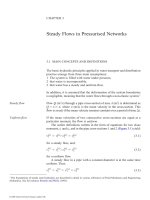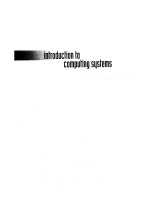Lecture Introduction to computing systems (2/e): Chapter 3 - Yale N. Patt, Sanjay J. Patel
Bạn đang xem bản rút gọn của tài liệu. Xem và tải ngay bản đầy đủ của tài liệu tại đây (1.26 MB, 51 trang )
Chapter 3
Digital Logic
Structures
Copyright © The McGraw-Hill Companies, Inc. Permission required for reproduction or display.
Transistor: Building Block of Computers
Microprocessors contain millions of transistors
• Intel Pentium II: 7 million
• Compaq Alpha 21264: 15 million
• Intel Pentium III: 28 million
Logically, each transistor acts as a switch
Combined to implement logic functions
• AND, OR, NOT
Combined to build higher-level structures
• Adder, multiplexor, decoder, register, …
Combined to build processor
• LC-2
32
Copyright © The McGraw-Hill Companies, Inc. Permission required for reproduction or display.
Simple Switch Circuit
Switch open:
• No current through circuit
• Light is off
• Vout is +2.9V
Switch closed:
• Short circuit across switch
• Current flows
• Light is on
• Vout is 0V
Switch-based circuits can easily represent two states:
on/off, open/closed, voltage/no voltage.
33
Copyright © The McGraw-Hill Companies, Inc. Permission required for reproduction or display.
N-type MOS Transistor
MOS = Metal Oxide Semiconductor
• two types: N-type and P-type
N-type
• when Gate has positive voltage,
short circuit between #1 and #2
(switch closed)
• when Gate has zero voltage,
open circuit between #1 and #2
(switch open)
Gate = 1
Gate = 0
Terminal #2 must be
connected to GND (0V).
34
Copyright © The McGraw-Hill Companies, Inc. Permission required for reproduction or display.
P-type MOS Transistor
P-type is complementary to N-type
• when Gate has positive voltage,
open circuit between #1 and #2
(switch open)
• when Gate has zero voltage,
short circuit between #1 and #2
(switch closed)
Gate = 1
Gate = 0
Terminal #1 must be
connected to +2.9V.
35
Copyright © The McGraw-Hill Companies, Inc. Permission required for reproduction or display.
Logic Gates
Use switch behavior of MOS transistors
to implement logical functions: AND, OR, NOT.
Digital symbols:
• recall that we assign a range of analog voltages to each
digital (logic) symbol
• assignment of voltage ranges depends on
electrical properties of transistors being used
typical values for "1": +5V, +3.3V, +2.9V
from now on we'll use +2.9V
36
Copyright © The McGraw-Hill Companies, Inc. Permission required for reproduction or display.
CMOS Circuit
Complementary MOS
Uses both N-type and P-type MOS transistors
• P-type
Attached to + voltage
Pulls output voltage UP when input is zero
• N-type
Attached to GND
Pulls output voltage DOWN when input is one
For all inputs, make sure that output is either connected to GND or to +,
but not both!
37
Copyright © The McGraw-Hill Companies, Inc. Permission required for reproduction or display.
Inverter (NOT Gate)
Truth table
In
Out
0 V 2.9 V
2.9 V
0V
In
Out
0
1
1
0
38
Copyright © The McGraw-Hill Companies, Inc. Permission required for reproduction or display.
NOR Gate
Note: Serial structure on top, parallel on bottom.
A
B
C
0
0
1
0
1
0
1
0
0
1
1
0
39
Copyright © The McGraw-Hill Companies, Inc. Permission required for reproduction or display.
OR Gate
A
B
C
0
0
0
0
1
1
1
0
1
1
1
1
Add inverter to NOR.
310
Copyright © The McGraw-Hill Companies, Inc. Permission required for reproduction or display.
NAND Gate (AND-NOT)
Note: Parallel structure on top, serial on bottom.
A
B
C
0
0
1
0
1
1
1
0
1
1
1
0
311
Copyright © The McGraw-Hill Companies, Inc. Permission required for reproduction or display.
AND Gate
A
B
C
0
0
0
0
1
0
1
0
0
1
1
1
Add inverter to NAND.
312
Copyright © The McGraw-Hill Companies, Inc. Permission required for reproduction or display.
Basic Logic Gates
313
Copyright © The McGraw-Hill Companies, Inc. Permission required for reproduction or display.
More than 2 Inputs?
AND/OR can take any number of inputs.
• AND = 1 if all inputs are 1.
• OR = 1 if any input is 1.
• Similar for NAND/NOR.
Can implement with multiple two-input gates,
or with single CMOS circuit.
314
Copyright © The McGraw-Hill Companies, Inc. Permission required for reproduction or display.
Practice
Implement a 3-input NOR gate with CMOS.
315
Copyright © The McGraw-Hill Companies, Inc. Permission required for reproduction or display.
Logical Completeness
Can implement ANY truth table with AND, OR, NOT.
A
B
C
D
0
0
0
0
0
0
1
0
0
1
0
1
0
1
1
0
1
0
0
0
1
0
1
1
1
1
0
0
1
1
1
0
1. AND combinations
that yield a "1" in the
truth table.
2. OR the results
of the AND gates.
316
Copyright © The McGraw-Hill Companies, Inc. Permission required for reproduction or display.
Practice
Implement the following truth table.
A
B
C
0
0
0
0
1
1
1
0
1
1
1
0
317
Copyright © The McGraw-Hill Companies, Inc. Permission required for reproduction or display.
DeMorgan's Law
Converting AND to OR (with some help from NOT)
Consider the following gate:
A B
A
B
A B
A B
0 0
1
1
1
0
0 1
1
0
0
1
1 0
0
1
0
1
1 1
0
0
0
1
To convert AND to OR
(or vice versa),
invert inputs and output.
Same as A+B!
318
Copyright © The McGraw-Hill Companies, Inc. Permission required for reproduction or display.
Summary
MOS transistors are used as switches to implement
logic functions.
• N-type: connect to GND, turn on (with 1) to pull down to 0
• P-type: connect to +2.9V, turn on (with 0) to pull up to 1
Basic gates: NOT, NOR, NAND
• Logic functions are usually expressed with AND, OR, and NOT
Properties of logic gates
• Completeness
can implement any truth table with AND, OR, NOT
• DeMorgan's Law
convert AND to OR by inverting inputs and output
319
Copyright © The McGraw-Hill Companies, Inc. Permission required for reproduction or display.
Building Functions from Logic Gates
We've already seen how to implement truth tables
using AND, OR, and NOT -- an example of
combinational logic.
Combinational Logic Circuit
• output depends only on the current inputs
• stateless
Sequential Logic Circuit
• output depends on the sequence of inputs (past and present)
• stores information (state) from past inputs
We'll first look at some useful combinational circuits,
then show how to use sequential circuits to store
information.
320
Copyright © The McGraw-Hill Companies, Inc. Permission required for reproduction or display.
Decoder
n inputs, 2n outputs
• exactly one output is 1 for each possible input pattern
2-bit
decoder
321
Copyright © The McGraw-Hill Companies, Inc. Permission required for reproduction or display.
Multiplexer (MUX)
n-bit selector and 2n inputs, one output
• output equals one of the inputs, depending on selector
4-to-1 MUX
322
Copyright © The McGraw-Hill Companies, Inc. Permission required for reproduction or display.
Full Adder
Add two bits and carry-in,
produce one-bit sum and carry-out.
A B Cin S Cout
0 0
0
0
0
0 0
1
1
0
0 1
0
1
0
0 1
1
0
1
1 0
0
1
0
1 0
1
0
1
1 1
0
0
1
1 1
1
1
1
323
Copyright © The McGraw-Hill Companies, Inc. Permission required for reproduction or display.
Four-bit Adder
324
Copyright © The McGraw-Hill Companies, Inc. Permission required for reproduction or display.
Combinational vs. Sequential
Combinational Circuit
• always gives the same output for a given set of inputs
ex: adder always generates sum and carry,
regardless of previous inputs
Sequential Circuit
• stores information
• output depends on stored information (state) plus input
so a given input might produce different outputs,
depending on the stored information
• example: ticket counter
advances when you push the button
output depends on previous state
• useful for building “memory” elements and “state machines”
325









